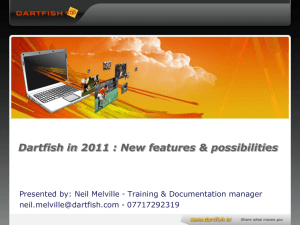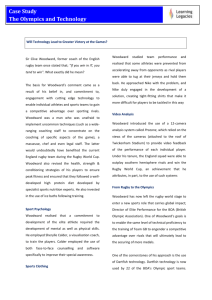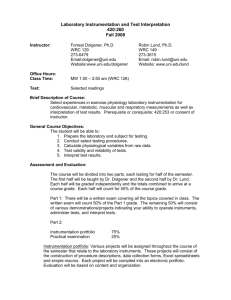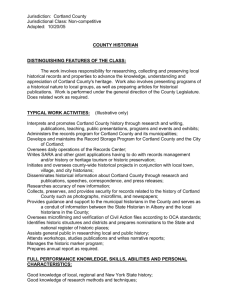State University of New York at Cortland
advertisement
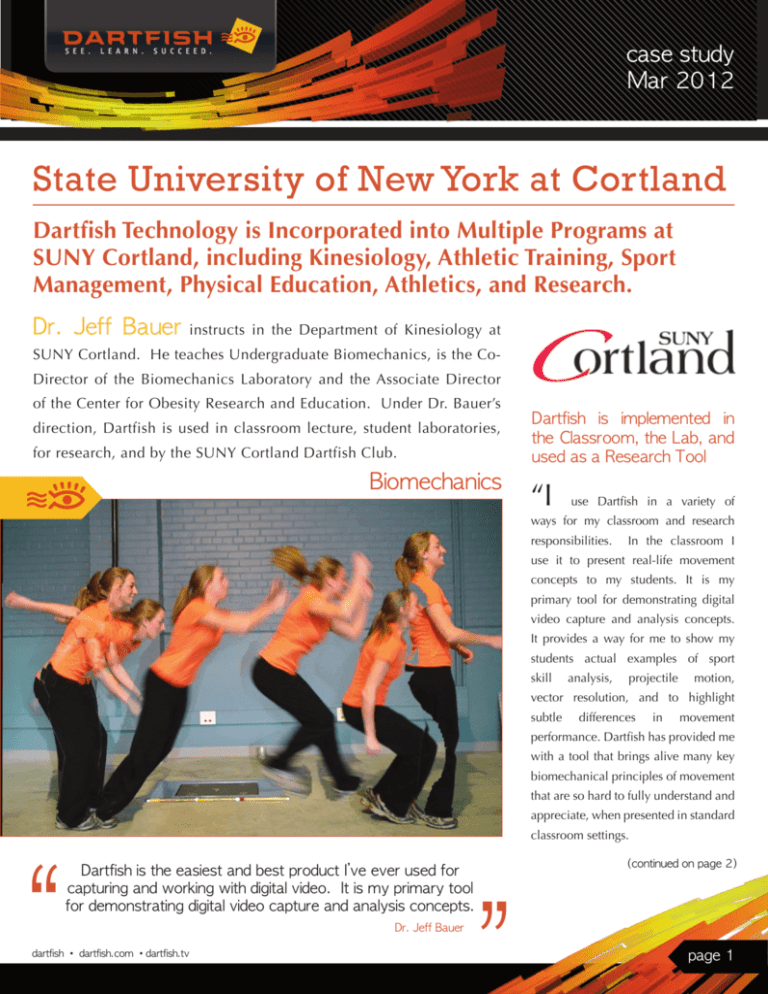
case study Mar 2012 State University of New York at Cortland Dartfish Technology is Incorporated into Multiple Programs at SUNY Cortland, including Kinesiology, Athletic Training, Sport Management, Physical Education, Athletics, and Research. Dr. Jeff Bauer instructs in the Department of Kinesiology at SUNY Cortland. He teaches Undergraduate Biomechanics, is the CoDirector of the Biomechanics Laboratory and the Associate Director of the Center for Obesity Research and Education. Under Dr. Bauer’s direction, Dartfish is used in classroom lecture, student laboratories, for research, and by the SUNY Cortland Dartfish Club. Biomechanics Dartfish is implemented in the Classroom, the Lab, and used as a Research Tool “I use Dartfish in a variety of ways for my classroom and research responsibilities. In the classroom I use it to present real-life movement concepts to my students. It is my primary tool for demonstrating digital video capture and analysis concepts. It provides a way for me to show my students actual examples of sport skill analysis, projectile motion, vector resolution, and to highlight subtle differences in movement performance. Dartfish has provided me with a tool that brings alive many key biomechanical principles of movement that are so hard to fully understand and appreciate, when presented in standard classroom settings. Dartfish is the easiest and best product I’ve ever used for capturing and working with digital video. It is my primary tool for demonstrating digital video capture and analysis concepts. (continued on page 2) Dr. Jeff Bauer dartfish • dartfish.com •dartfish.tv page 1 (continued from page 1) “Many students are visual learners,” explains Bauer, “so this ability to bring in annotated video clips to illustrate and tie them to similar videos and examples found in the e-text, Dynamic Biomechanics, used in my class, is invaluable in their grasping the full meaning of the mechanics of human movement.” Dynamic Biomechanics – an E-text Embedded with Video and Teamed with Dartfish Student Connect Software As a college professor, I believe I owe it to my students to teach courses with the most up-to-date, relevant, and useful materials and technologies, so I can help students learn and develop skills that will best prepare them for their future careers. I believe using Dynamic Biomechanics bundled with Dartfish Student Connect Software, provides me with the perfect combination of tools to achieve my goals as an instructor. It gives my students their best opportunity to succeed in the classroom and beyond. As a biomechanics lab instructor, I find that Dartfish is an invaluable tool for performing movement analysis. It enhances not only how I teach my labs, but also the learning of my students. It is also a program that is easy to learn and fun to use. Dynamic Biomechanics is an excellent resource for undergraduate biomechanics students. The information is comprehensive, it is easy to use, and the built in search engine makes it superior to any traditional textbook. Dartfish has provided me with a tool that brings alive many key biomechanical principles of movement that are so hard to fully understand and appreciate when presented in standard classroom settings. Dr. Jeff Bauer dartfish • dartfish.com •dartfish.tv page 2 Understanding Movement Mechanics and the Consequences of Actions is Critical Knowledge for Exercise Science and Physical Education Majors “It is critical for my students, who are primarily Exercise Science and Physical Education majors, to gain an appreciation of the mechanics of movement and the consequences of actions that place the body at risk of injury in sport and daily life situations,” states Dr. Bauer. “Of course being a biomechanics instructor, I believe that an introductory course in basic biomechanics is the perfect place for students to begin to gain that knowledge. I teach biomechanics from the perspective that to fully understand what is happening when a person performs some movement, you must understand the underlying anatomy of the mover, the physics or mechanics that govern the movement and how relevant information to the movement can be accurately captured and analyzed. “When the students have the opportunity to actually perform the movements themselves, video them, and conduct an actual biomechanical analysis of the actions, it often results in that ‘Ah hah!’ moment for which all instructors strive.” Dr. Jeff Bauer During lecture when discussing kinematic (describing motion relative to time and spatial considerations) or kinetic (the effects of force on an object) concepts, I can insert video clips or still images captured using Dartfish to enhance my lecture materials. This allows me the opportunity to take relevant examples from my research or other sources and show them to my students. I believe it is very important to understand, not only the concepts associated with the physics of human movement, but also to gain an appreciation of the technology and effort associated with capturing useful biomechanical data.” Dr. Bauer’s Students are Exposed to Dartfish in a Variety of Classroom and Laboratory Experiences “As well as the students who take undergraduate Biomechanics,” Bauer clarifies, “Cortland Kinesiology students now have other unique opportunities to develop their movement analysis skills using Dartfish. Starting in the Fall of 2011, all incoming freshmen Exercise Science majors are required to take a new course, Computer Applications in Exercise Science. This is when they get their first exposure to Dartfish software. In this class, students are required to complete two small projects demonstrating their competency using Dartfish. Additionally, Athletic Training students are getting to work more with Dartfish.” dartfish • dartfish.com •dartfish.tv When the students have the opportunity to actually perform the movements themselves, video them, and conduct an actual biomechanical analysis of the actions, it often results in that ‘Ah hah!’ moment for which all instructors strive. Dr. Jeff Bauer page 3 Dartfish TV Used in Teaching Biomechanics Dr. Bauer’s Biomechanics Research Group Project: “At the beginning of each semester,” states Bauer, “I create a private collection for each of my students on our campus Dartfish TV Channel. The collection is accessible only by the student, my class graduate assistant, and me. Students upload all of their Dartfish assignments to their private collection where they are reviewed and graded. The students do not have the option to Each group will be comprised of no more than 4 students. All group members will complete the following activities while being videotaped: delete uploaded assignments, but may upload as many rough drafts as they wish, prior to the due dates of the assignments. This arrangement allows students to upload drafts of their assignments, if they wish for me to review with comments, before their final assignment deadline. All final assignments remain in their private collection space until after final semester grades are 1. Maximum effort vertical countermovement jump on the force plate 2. High bar back squat assigned. This arrangement greatly reduces the time and hassle of collecting and returning student Dartfish assignments. Having access to their own private collection space, eliminates the need for them to create Mediabooks that 3. Four meter walking trial must be emailed, posted to a DropBox account, or copied from a flash drive 4. Exercise skill selected by the to the instructor’s computer for grading. They can now upload their Dartfish group Mediabooks directly to their own SUNY Cortland Biomechanics Channel collection, submitting completed work from any internet compatible All movements will be captured in the Biomechanics Lab during your scheduled lab meeting time and the videos moved to your class drop-off folders. computer running Dartfish. (continued on page 5) dartfish • dartfish.com •dartfish.tv page 4 Dartfish Mediabook: (Individually graded: 60% of project grade) Each group member is required to do a complete analysis of ONE of the four movements listed above. Each student must create a Dartfish Mediabook in which they: 1. Analyze the movement of each group member, as they perform the skill they are evaluating. 2. Do a literature review (minimum 5 referred journal articles properly sited using APA format) to support the analysis of the skill. All citations must be complete and inserted into the comments sections of the skill key positions. A minimum of 4 key positions must be identified for each student performing the task. The first key position MUST be inserted at the start of the video clip. In the label area for the first key position insert your name, and in the notes section of the first key position you must insert an alphabetized complete list of all works cited in the Mediabook. References and proper formatting count 25% of your grade! 3. Students should use all appropriate annotation tools (clocks, angle measurements, drawings, etc.) to provide the best qualitative and quantitative analysis possible. Graphs and comparative analysis data from the Excel portion of the project should be included where appropriate in the Dartfish Mediabook. 4. The Mediabooks must include a video of each student in the group performing the skill and the Mediabooks must be appropriately labeled and named. Excel Spreadsheet: (Group graded: 20% of project grade) 1. Each group must create a spread sheet with all measurement data captured from each of the individual Dartfish projects for the group. All data must be clearly inputted, accurately labeled and identifiably related to the specific group member who provided the data. 2. Comparisons showing similarities and differences in performance measures across group members must be calculated and graphed. Each graph must be appropriately labeled. A chart title, axis titles, data titles, and correct data units must be used. 3. Inappropriate analysis, labeling, etc. will count against the entire group’s grade. 4. The name of the Excel file to be turned in must be named: EXCEL PROJECT followed by the last names of all group members listed alphabetically. Ex. EXCEL PROJECT Bauer Dow Madison Wembley 5. The full names of each group member must be located in cell A1 of the first sheet of the Excel spreadsheet. dartfish • dartfish.com •dartfish.tv (continued on page 6) page 5 Courses Utilizing Dartfish at SUNY Cortland Exercise Science Courses Undergraduate Courses: EXS111 – Computer Applications in Exercise Science EXS387 - Biomechanics Dartfish use is optional in: EXS489 – Research Methods EXS490 – Independent Research in Exercise Science Sport Management Courses Undergraduate Courses: SPM 236 - Digital Video Analysis SPM 335 - Information Technology in Sport SPM 336 - Advanced Digital Video Analysis SPM 435 - Applied Information Technology in Sport Graduate Courses Part of the PE Coaching Master’s Program: SPM 536 - Digital Video Analysis SPM 537 - Advanced Digital Video Analysis SPM 538 - Applied Digital Video Analysis Sport Management Program SPM 635 – Information Technology in Sport Power Point Presentation: (Individually graded: 20% of project grade) 1. Each group must create a PowerPoint presentation of at least 15 slides discussing all of the steps of the project and the various outcomes of the individual group members’ analyses. 2. Any information not specifically created by a group member used in the presentation must be appropriately cited using APA format. That includes information from the literature reviews, graphics used in the presentation, etc. 3. Points of similarity and differences between the analyses made by the group should be discussed. 4. This presentation should be able to convey the steps, goals, and outcomes of the group project to a target audience of students preparing to take an undergraduate Biomechanics class or a high school senior class studying Kinesiology. 5. The presentation may follow the general presentation outline provided on our class WebCT site. 6. The complete names of all group members, listed alphabetically, must be present on the Title Page of the presentation. Turning in Materials to be Graded: 1. Each group member must copy their portion of the project to one group members Dartfish.TV Channel. 2. The EXCEL and POWERPOINT and MEDIABOOK portions of the project should be copied to channel of the group member whose last name appears first alphabetically. 3. Keep a copy of all materials until grades are posted for the project. Physical Education and Athletics Physical Education Within the Graduate and Undergraduate Physical Education Programs at SUNY Cortland, Dartfish Technologies are infused into the curriculum. A special emphasis is placed on the analysis of video within the context of curricular performance. “Physical Education Majors in selected courses learn to use certain modules of the Dartfish Software TeamPro program. Specifically, In the Action, Player, and Analyzer modules are utilized to maximize student performance, teaching cues, and corrective feedback,” explains Dr. Gary Babjack, who instructs in these programs. “Undergraduate students in Bowling, Archery, Gymnastics Activities, Self-Defense and Dance have been exposed to the use of Dartfish. dartfish • dartfish.com •dartfish.tv (continued on page 7) page 6 (continued from page 6) In the Graduate Program, extensive training is employed during a summer residency program which highlights the fundamental principles of coaching and the integration of Dartfish.” Women’s Gymnastics Takes ECAC Division III Title Gary Babjack began his 14th season as SUNY Cortland’s Women’s Gymnastics Head Coach in 2011-12. In 2011, Babjack earned National Collegiate Gymnastics Association (NCGA) National Coach of the Year and National Association of Collegiate Gymnastics Coaches for Women (NACGCW) East Region Coach of the Year honors, after leading the Red Dragons to an ECAC Div. III title and a tie for fourth at the NCGA national meet. “The varsity gymnastics team at SUNY Cortland uses Dartfish extensively for instantaneous feedback for each daily practice,” states Coach Babjack. “Four permanent computer stations are dedicated to the four Olympic Events found in Collegiate Gymnastics. Athletes have an opportunity to immediately review their latest performance at pre-set timed intervals. We are then able to save digital video clips of each performance. Analysis of performance, comparison to previous performance and highlighted areas of focus are common forms of instantaneous feedback. This powerful technology has propelled Cortland to a current ranking of #1 in the nation for Division III gymnastics, a spot Cortland has been accustomed to in the last decade. This digital video technology software package enables the athletes to refine Gymnasts work the rings, while teammates get instant performance feedback at one of four Dartfish computer stations. obvious errors of performance and allows the coaches to validate their perceptions while accurately communicating necessary focus points for improved precision of the athletes’ practice efforts.” This powerful technology has propelled Cortland to a current ranking of #1 in the nation for Division III gymnastics a spot Cortland has been accustomed to in the last decade. Coach Gary Babjack dartfish • dartfish.com •dartfish.tv page 7 Athletic Training and the SUNY Cortland Channel on Dartfish.tv Athletic Training majors now have a site on the campus Dartfish TV Channel that they can use to view over 120 videos with comments, allowing them to watch their orthopedic examination skills being correctly performed by their faculty instead of just reviewing class notes and textbook illustrations. Julie M. Cavallario, MS Ed., ATC, the Interim Clinical Coordinator, a Clinical Instructor, and Certified Athletic Trainer at SUNY Cortland, has currently implemented the use of Dartfish TV in an orthopedic examination class, within the Athletic Training Education Program Curriculum. “One of the inherent problems with teaching hands-on skills in the classroom is that it requires the student to practice technique on their own without the guidance and correction of an instructor, in order to become proficient at it,” states Cavallario. “I have been an instructor in Athletic Training Education for 7 years, and my greatest frustration is when a student practices a skill wrong, because they can’t remember exactly what they were told. I have created videos demonstrating the correct orthopedic testing technique for each test they are taught during the course of this class. The students have access to this outside of the classroom, and it has already greatly improved retention and skill performance for the students using it. I have actually had students from previous years contact me to complain that this resource wasn’t made available to them when they took the class. This is definitely a tool that I will continue to use in the future. I think it will have a great impact, not only on my instructional technique, but on student performance and skill retention as well.” Dartfish is definitely a tool that I will continue to use in the future. I think it will have a great impact, not only on my instructional technique, but on student performance and skill retention as well. Julie M. Cavallario, ATC Sport Management Dr. Peter Han, teaching in the Sport Management Department at SUNY Cortland, introduces Dartfish in his class, SPM 335, Information Technology in Sport. “I usually spend 2 to 3 class periods covering Dartfish. During these classes, students learn a few basic functions of Dartfish and also discuss its use in sports broadcasting,” states Han. “The level of interest and the feedback from students is incredibly positive. Dartfish has been helping those students, the ones who further their interest and become proficient in Dartfish, to secure internships and even jobs in the sport industry. I have no doubt that Dartfish allows our students to be more viable candidates in this very competitive job/internship market in sports. From an instructor’s standpoint, I am very thankful that I am able to provide our students a very unique opportunity to learn about this state-of-art technology in sport.” dartfish • dartfish.com •dartfish.tv page 8 Nick Wilson, a Graduate Student in Sport Management at SUNY Cortland Starts His Own Business Using Dartfish “Dartfish is the tool for success,” states Wilson. “I have recently started my own online business using Dartfish called My Cyber Coach, where I can analyze people all across the globe. It’s become a great side job that I would like to turn into a career. Dartfish has also helped in other areas, not just in athletic performance. In the Sport Management field, internships and jobs are extremely competitive. Having the knowledge and experience of Dartfish listed on my resume, has definitely helped me receive interviews, internships, and job offers.” www.mycybercoach.com Internships A significant advantage for students in the Exercise Science and Sport Management Programs at SUNY Cortland is the opportunity to engage in Internships, where their proficiency bridges into real life opportunities to apply their learning and to launch future careers. Drew Bergmann, a SUNY Cortland Sport Science Student tells his story. “Dartfish helped get me the perfect internship working as an athletic trainer and Dartfish technologist at an elite winter sports college-prep academy, Stratton Mountain School in Vermont. I had always seen the potential in Dartfish, but was unsure where to fit it into my career as an athletic trainer. Then, my skills with Dartfish got me an internship where I use it every day. Not to mention that it helped open the door to the exciting new world of competitive ski racing. I began using Dartfish in Dr. Bauer’s biomechanics class and could immediately see the benefits. I began to do extra work for Dr. B, not really knowing where it would lead me. It led to an internship at Stratton Mountain School, where I am able to incorporate my Dartfish skills and my athletic training skills on a daily basis. This opportunity is invaluable to my career as an athletic trainer and I learn new things about Dartfish every day.” I have no doubt that Dartfish allows our students to be more viable candidates in this very competitive job/internship market in sports. Dr. Peter Han “Dartfish helped get me the perfect internship working as an athletic trainer and Dartfish technologist at an elite winter sports college-prep academy, Stratton Mountain School in Vermont.” SUNY Cortland Intern Drew Bergman dartfish • dartfish.com •dartfish.tv page 9 The SUNY Cortland Dartfish Club The SUNY Cortland Dartfish Club, was initiated through the efforts of Cortland Kinesiology majors in the Fall of 2011. It’s an organization that gives students an opportunity to work with and expand their mastery of Dartfish technologies through a variety of projects and learning experiences. The club is open to any Cortland student, whether an expert or a complete novice in the use of Dartfish. Students in the club use a special dedicated computer lab equipped with six workstations running Dartfish 6.0 TeamPro software as their meeting/work place. Club members agree to provide service to the campus and selected organizations, such as the USTA, in ways that promote the exposure and application of Dartfish technologies. Students meet two or more times a week to discuss uses of Dartfish and to learn more about the functions and capabilities of Dartfish software, Dartfish TV, and video technology. Faculty sponsor, Dr. Jeff Bauer, a Certified Dartfish Technologist, meets with students and provides instruction and guidance in using Dartfish. Currently there are 15 active club members, with more students expressing interest all the time. All members aspire to become highly skilled in using Dartfish and video technologies, while getting to work with other students having similar interests and career goals. Jeff Bauer Ph.D – A Professor at SUNY Cortland, Dr. Bauer teaches undergraduate Biomechanics. He is the Co-Director of the Biomechanics Laboratory and the Associate Director of the Center for Obesity Research and Education. After earning his degrees in (BS) Computer Science, (Ph.D.) Exercise Science specializing in Biomechanics from Pennsylvania State University, Dr. Bauer worked in the private sector as a Senior Systems Analyst for General Electric’s Aerospace Division. His teaching career began at the University of Florida at Gainesville, moving to SUNY Cortland in the fall of 2000. Bauer’s research interests focus on the long term effects of ACL injury and obesity on gait, the use of technology in the classroom, and renewable energy capture/usage from exercise. dartfish • dartfish.com • dartfish.tv • 1.888.655.3850 page 10
